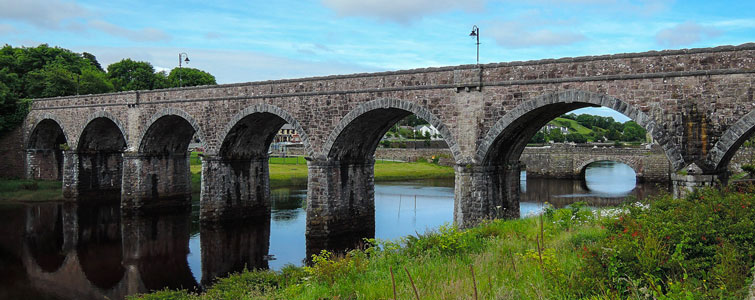History of the Great Western Greenway in Co. Mayo

In Ireland the 19th century saw the birth and rapid expansion of the railway system.
The first railway opened in October 1834 and linked Dublin to Kingstown Harbour (Dún Laoghaire) to the South. Between 1834 and 1846 many other lines were opened operating from Dublin including the Great Northern Railway, the Great Southern & Western Railway.
Only in 1861 a line from Dublin reached County Mayo when the Midland & Great Western Railway built the track between Castlerea in County Roscommon and Ballyhaunis in County Mayo. In May 1862 the rail route was extended to Claremorris and in December 1862 to Castlebar and four years later, in January 1866, to Westport. The track from Westport town to the busy Quay at Westport Harbour was added in 1874 to facilitate the movement of goods to the town and further inland.
In the 1890s a new line was built linking Westport to Achill Sound, known as Balfour Lines. Arthur J. Balfour, Chief Secretary of Ireland between 1887 and 1891, introduced an Act providing State assistance for the construction of light railways to disadvantaged areas in Ireland and the line Westport-Achill was proposed. The first track, opened in February 1894, covered the distance between Westport and Newport, followed by Mulranny in August 1894.
The following year the last track Mulranny-Achill Sound was inaugurated on 13th May 1895. The whole area benefited from the new railway line and towns prospered. The tourism, trade and postal system improved and new jobs were created in the construction and maintenance of the railway. It is said over 1000 men were employed. Goods, such as eggs and fish, were easily carried up to Dublin on daily basis and more turf was harvested and sent from Achill to Dublin.
The Irish railway companies became involved in the hotel business and the luxury hotel, nowadays known as Mulranny Park Hotel, was built and opened in 1897 and from 1898 a combined rail and hotel tickets went on sale. The hotel was equipped with electric lights, hot and cold water baths and a seawater swimming pool. Guests could easily have access to beaches, golf links and boats walking a causeway from the hotel to the main amenities across the bay.
Unfortunately with the new coming of cars and improvement of the road systems the track never consistently reached the levels originally anticipated and in 1934 the passenger service was closed down.
The Westport-Newport railway line fulfilled an ancient prophecy. Two hundred years earlier, Brian Rua O'Cearbhain, a man from Erris, had prophesied that “carriages on the iron wheels, emitting smoke and fire would carry coffins to Achill on both its first and last train journey”.
In fact in 1894, the first train on the Achill railway carried the bodies of the victims of the Clew Bay Drowning. Thirty-two young people left Achill on a “Hooker” to meet up with a steamer at Westport Quay. Seeing the ship they moved to one side of the Hooker to have a better look, suddenly a blast of wind overturned the boat and they all drowned. They were on their way to Scotland for potatoes picking (tattie hoking).
The second tragedy, which fulfilled the prophecy, occurred in 1937. Ten young people from Achill were buried alive in a ‘bothy’ (hut) in Kirkintilloch, Scotland. As in the past they traveled to Scotland for potatoes picking. Their bodies were shipped to Dublin and the line reopened to allow a specially commissioned train to carry them back to Achill. The burial took place in Kildownet Cemetery.
The steel tracks were lifted by the Irish Transport System in 1938 and sold to Germany, hungry for steel, during the Word War II.
